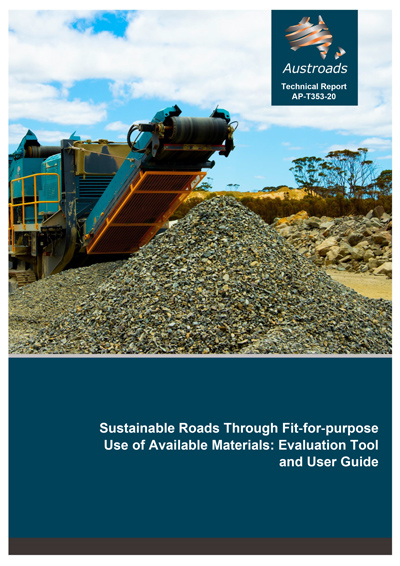Asset Management

Sustainable Roads Through Fit‑for‑purpose Use of Available Materials: Evaluation Tool and User Guide
- Publication no: AP-T353-20
- ISBN: 978-1-925854-91-6
- Published: 11 March 2020
- PDF (free) Download
This guidance document aims to encourage fit‑for‑purpose use of available materials for sealed and unsealed road construction and maintenance, including renewal of low to medium level traffic roads.
A fit‑for‑purpose material has properties and performance characteristics which are directly suited to the chosen design application. The use of a fit-for-purpose material ensures budget resources are optimised over the entire life cycle of the pavement, while continuing to meet a required level of service.
Understanding what influences material performance and how to balance this with budget optimisation and level‑of‑service requirements are key to a fit-for-purpose material.
- Summary
- 1. Introduction
- 1.1 Background
- 1.2 Scope and Purpose of This Project
- 1.3 Purpose of This Document
- 1.4 Structure and Contents of This Document
- 2. Assessment Process and Purpose(s)
- 2.1 Introduction to the Process
- 2.2 Assessment Purpose and Examples
- 2.3 Critical Ideas
- 3. Material Risk Assessment
- 3.1 Material Information
- 3.1.1 Material Source
- 3.1.2 Material Properties
- 3.2 Load Information
- 3.2.1 Moisture
- 3.2.2 Traffic
- 3.3 Assessing Material Risk
- 3.3.1 Sealed or Unsealed
- 3.3.2 Traffic Conditions
- 3.3.3 Moisture Probability
- 3.3.4 Risk Assessment Category
- 3.3.5 Material Category: Sealed Roads
- 3.3.6 Risk Assessment
- 3.3.7 Good Practice Techniques
- 3.4 Critical Ideas
- 3.1 Material Information
- 4. Material Options Assessment
- 4.1 Risk Reduction Options
- 4.1.1 Material Management
- 4.1.2 Moisture Management
- 4.2 Assessing Material Options
- 4.3 Revised Design Information
- 4.4 Critical Ideas
- 4.1 Risk Reduction Options
- 5. Life-cycle Cost Assessment
- 5.1 Level of Service
- 5.1.1 Operating Criteria
- 5.1.2 Performance Criteria for Sealed Roads
- 5.1.3 Additional Functionality Requirements
- 5.2 Road Performance Models
- 5.2.1 General
- 5.2.2 Sealed Road Deterioration and Works Effects Models
- 5.2.3 Unsealed Road Deterioration and Works Effects Models
- 5.3 Economic Costs and Option Selection
- 5.3.1 General
- 5.3.2 Road Agency Costs
- 5.3.3 Road User Costs (RUC)
- 5.3.4 Sources of Cost Savings
- 5.4 Critical Ideas
- 5.1 Level of Service
- References
- Appendix A Performance Risk Assessment
- Appendix B Case Studies
- B.1 Gascoyne Region, Western Australia
- B.1.1 Risk Assessment Input Data and Outcome
- B.1.2 Options Assessment
- B.1.3 Comparison of Options
- B.1.4 Options Rating
- B.1.5 Revised Information
- B.2 Goldfields-Esperance Region, Western Australia
- B.2.1 Risk Assessment Input Data and Outcome
- B.2.2 Options Assessment – Regional Roads
- B.2.3 Comparison of Options
- B.2.4 Options Rating
- B.2.5 Revised Information
- B.2.6 Options Assessment – City Centre Road (Esperance)
- B.2.7 Comparison of Options
- B.2.8 Options Rating
- B.2.9 Revised Information
- B.3 Central West Region, Queensland
- B.3.1 Overview
- B.3.2 Performance Trends
- B.3.3 Economic Analysis
- B.3.4 Further Development of This Case Study
- B.4 Cassowary Coast, Queensland
- B.4.1 Overview
- B.4.2 Observed Performance
- B.4.3 Life-cycle Analysis
- B.5 Colac Otway Region, Victoria
- B.5.1 Overview
- B.5.2 Types and Properties of Available Materials
- B.5.3 Investigation of Blended Materials
- B.6 Port Macquarie-Hastings, New South Wales
- B.6.1 Overview
- B.6.2 Results of Desktop Blending Analysis
- B.1 Gascoyne Region, Western Australia
Related publications
WEB-AAM6164-1
Latest Asset Management News
